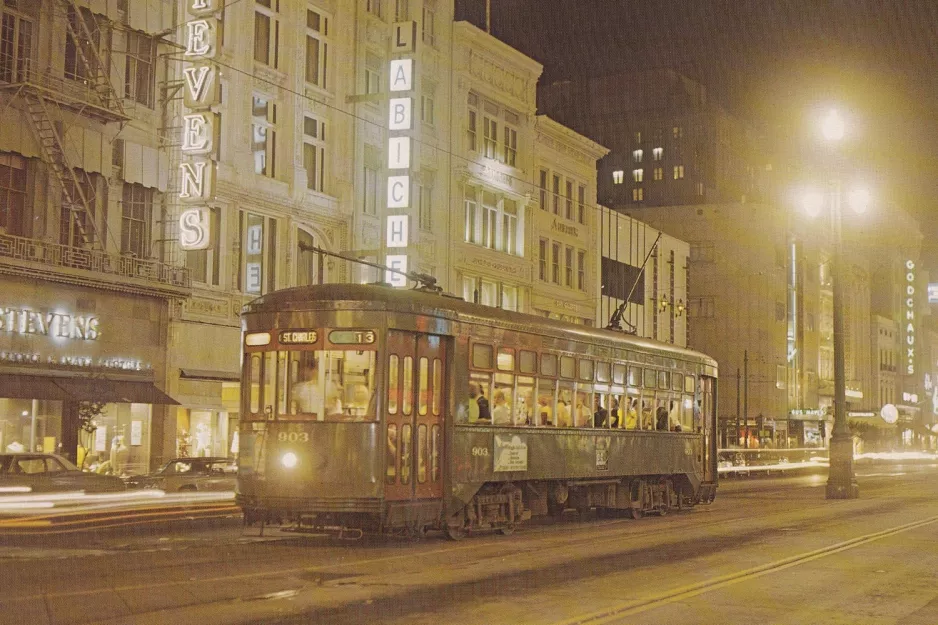Postkort: New Orleans linje 12 St. Charles Streetcar med motorvogn 903 nær St Charles / Melpomene (1971)
Stoppested: St Charles / Melpomene.
Arkiv: Henrik Boye.
Fotograf: Gary Allan.
Udgiver: Vanishing Vistas.
Dato: 1971.
By: New Orleans (USA).
Billedet viser
New Orleans Regional Transit Authority (NORTA)
I drift
New Orleans linje 12 St Charles Streetcar: S Claiborne - Canal / Carondelet
I drift
New Orleans motorvogn 903, type Perley A. Thomas Car Works, serie 900.
Beskrivelse
Unique though New Orleans may bi in other respects, the city is justifiably distinctive in the realm of public transport, for street cars are operated today in fewer than a dozen cities in all of North America. Out of a citywide network which embraced 725 cars and 221 miles of track in 1924, only online and 35 cars exist at the present time (1972). Besides its distinction simply as a symbol of survival, however, this St. Charles Avenue line also possesses other noteworthy characteristics. It was the second street railway in the world to be founded, service having commenced in 1835, and it is now the oldest urban rail transit line on earth; it is the only remaining 2-man street-car operation in the U.S.A.; and its track gauge is six inches wider than standard, measuring 5 feet 2½ inches.
The downtown end of the line just one block long on Canal Street, between Carondelet and St. Charles Avenues, where this photograph was taken. The cars run over a single track in St. Chales Avenue to Lee Circle (Howard Street), thence over a double-track line to the outer terminus at S. Carrolton and S. Claiborne Avenues, a distance of 7½ miles. On the return trip the route diverges at Lee Circle, following a single track in Carondelet Avenue back to Canal Street. the entire route forms a great arc parallel to the northern bank of the Mississippi River, hich flows south of the city's center.
The cars pass LOyola and Tulane Universities, Audubon Park, and the Garden District, a section of old and lovely homes. Beyond Lee Circle, with its statue of the famous General (facing north, as do all Confederate Civil War memorials), the line goes through a fine residential area whose atmosphere is enhanced by large trees bordering the thoroughfare. Except for that portion of the track forming the local parlance, separating a pair of 2-lane paved roadways. Tall trees growing along the edges of the grass strip arch over the double track, forming a leafy "tunnel". This contrasts sharply with the single track in the narrow downtown streets, where considerable track reconstruction was performed in early 1970.
The New Orleans' street car system is owned and operated by New Orleans Public Service, Inc., a company which also owns and operates the city's gas end electricity generation and distribution facilities. Though this company's corporate genesis extends back no farther than 1919, the street car line itself can trace its ancestry to the New Orleans and Carrolton Railroad, which received its charter in 1833 and inaugurated "street car" service in January of 1835 with a steam engine and cars borrowed from a local railroad. That was barely two years after the opening (on November 14, 1832) of the pioneer, now-defunct New York and Harlem Railroad line in New York City.
NOPSI's newest cars, purchased in 1928, are not the ones which still survive. Instead, those which are in use today belong to a group of 173 (numbered 800-972) built in 1922 and 1924 by Brill (#800-831, 852-894) in Philadelphia, and by Perley A. Thomas Car Co. of High Point, North Carolina. These cars are 47 feet 8 inches long, 8 ffet 4 inches wide, and 11 feet 4 inches high, with two 4-wheel trucks spaced on 22-foot 6-inch centers. The 903, depicted here, is equipped with 65-hp. GE traction motors and controls and weighs 21 tons, 1000 lbs. heavier than other cars with Westinghouse equipment. One motor is geared to the inner axle of each of the Brill type 76-82 trucks with 33-inch diameter wheels spaced 4 feet 10 inches apart. At the time of their construction these cars represented the ultimate in street car desing. Their underframes, bolsters, and side and end sheathing were fabricated of steel, with their roofs and interiors being composed of wood. Between 1966 and 1969 the exterior woodwork man or conductor operate the doors on the earlier cars. The seating capacity accommodates 52 passengers: 36 on 9 pair of wooden seats arranged crossways in the middle section of the carbody, and 16 more on four longitudinal seats, two of which are located at each end of the car adjacent to the operating and loading platforms.
New Orleans Public Service, Inc.
JT-518 J6432

Se billedet i høj opløsning. Venligst giv besked hvis billedet benyttes, og indsend gerne dine egne sporvognsbilleder.